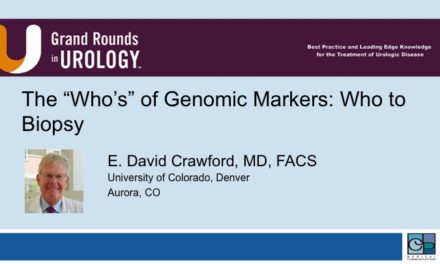
PCa Commentary | Volume 195 – November 2024
Posted by Edward Weber | November 2024
NEW CLINICAL DEVELOPMENTS:
-
The PATCH Trial
-
Outcome of Active Surveillance in the PASS Study
-
Artificial Intelligence in Patient Selection for Active Surveillance.
1) The PATCH Trial Results in Perspective:
Lupron was approved for the treatment of metastatic prostate cancer in 1985 based on several seminal articles establishing Lupron as equivalent to orchiectomy and oral estrogen but having fewer adverse effects than estrogen. Tolis, et al. (Proc Natl Acad ScDLi USA, 1982) found Lupron effective in lowering serum testosterone to castrate levels to a similar extent as surgical castration (Labrie, et al. (J Urol 1984). Chodak, et al. (J Urol. 1896) found Lupron equivalent to oral estrogen and surgical castration in lowering testosterone and controlling metastatic disease. These endorsements of Lupron for the treatment of metastatic prostate cancer represented a significant sea change in the management of the disease and continue to be the standard of care.
The PATCH trial now stands in a similar pivotal position as Lupron in 1985 in the management of metastatic prostate cancer by providing an equally effective option as Lupron for lowering testosterone and treating disease. The PATCH trial results were reported in abstract form at the 2024 European Society for Medical Oncology conference by Dr. Langley, the principal investigator. The PATCH (“Prostate Adenocarcinoma Transcutaneous Hormone”) study compared the effectiveness of transdermal estradiol (tE2) to Lupron in 1360 men with newly diagnosed locally advanced non-metastatic prostate cancer +/- positive pelvic nodes (Stage MO, i.e., no metastases) with Gleason Scores 7 – 10 (94%), median PSA values of 24.4 ng/mL and whose PSAs were rising faster than 9 months. tE2 was dosed at four 100mcg/24-hour patches changed twice weekly for
> 2 years and reduced to 3 when testosterone was <50 ng/dL. The participants were negative on CT, bone scan, and MRI.
- At 3 years metastasis-free survival was the same for both agents ~86 to 87%. Overall survival was similar over 14 years of follow-up.
- The adverse effects profile favored tE2, reducing hot flushes from 89% (Lupron) to 44% (tE2). At 2 years bone mineral density improved by 7.9% ( tE2) vs. a -3% worsening for Lupron. This change occurred rapidly over the first year. tE2 provided an improved quality of life.
- Cardiovascular adverse effects (heart failure, angina, myocardial infarction, and thromboembolic strokes) were similar, about 7-10%. However, gynecomastia developed in 85% (tE2) vs. 44% (Lupron). Prophylactic low-dose radiation to breast tissue lessens this development.
- Langley concluded: “Transdermal estrogen provides choice about expected side effects and route of administration allowing personalized treatment plans. Transdermal estradiol should be a standard-of-care ADT option in M0 disease.”
It may take some time before this option is incorporated into clinical practice.
2) “Long-Term Outcomes in Patients Using Protocol-Directed Active Surveillance for Prostate Cancer” (Newcomb et al., JAMA. 2024)
The PASS study (The Canary Prostate Active Surveillance Study) presented the outcome of 2155 men with Gleason Grade 1 cancers (Gleason Score 3+3) followed at 10 North American centers between 2008 and 2022. The men’s median PSA was 5.2 ng/mL and the median follow-up was 7.2 years. After the initial qualifying biopsy, these Gleason Grade 1 participants were followed with clinical examinations and PSA testing every 6 months. A confirmatory biopsy was mandated 6 to 12 months after diagnosis, and subsequent biopsies were required every 2 years. Later in the study a pre-biopsy MRI and biomarker tests were done at the physician’s discretion.
At the confirmatory biopsy at .7- 1.3 years 23% were reclassified: 70% from GG1 to GG2 (Gleason Score 3+4); 23% from GG1 to GG3 (Gleason Score 4+3) or more. Those who were upgraded to GG > 3 on any subsequent biopsy were removed from the study and 88% were treated.
Findings: Over 10 years of follow-up 43% of men had been reclassified and 49% had been treated (some by choice). Overall, at 10 years 1.4% of men had developed metastases, and 0.1% experienced cancer-specific mortality. The clinically significant outcome: “The findings show that long-term clinical outcomes of adverse pathology, recurrence or metastasis are equal in men who undergo treatment immediately following the first biopsy after diagnosis compared to men who undergo treatment after several years of surveillance. Later progression and treatment during surveillance were not associated with worse outcomes.”
Perspective: These excellent results are dependent upon diagnosing cancer at an early stage
(i.e., GG1) which results from PSA screening. The current thrust of screening, however, is to combine multiple biomarkers in the screening protocol to diagnose only those men with clinically significant cancer (GG 3 or higher) for whom treatment is appropriate.
Examples of those screening protocols: Quantifying the Risk of Finding Cancer with Gleason Grade 2 or More on Biopsy: In recent years several tests have been developed to guide biopsies by estimating the likelihood of having cancer with a Gleason Score greater than 3+3 (i.e., having GG > 2) on the belief that intervention in the lower Gleason Grade1 cancer is rarely indicated and, if found, that active surveillance would be recommended. Those tests include the Prostate Health Index (PHI) – based on blood, the 4-kallikrein Score (4Kscore)- based on blood, MyProstateScore2 (MPS2) – post-DRE urine-based, SelectMDX – post-DRE urine-based and IsoPSA – blood-based. Collectively, these tests have high negative predictive values of 93-100% for ruling out the presence of GG 2 or higher cancers.
If lower-grade cancer is discovered, active surveillance is the NCCN-recommended management. Men with GG2 (GS 3+4) with low percentages of pattern 4, i.e., ~ 5%, are considered appropriate candidates for AS.
3) Artificial Intelligence to Guide Patient Selection for Active Surveillance.
Researchers at Johns Hopkins have a long experience in selecting and following men on active surveillance and have accumulated an extensive database of their characteristics, biomarkers and outcomes. Based on these data they published “Predicting prostate cancer grade reclassification on active surveillance using a deep learning-based grading algorithm,” Ding et al., Journal of the National Cancer Institute, June. 2024. Using a soon-to-be-commercially available *AIRAProstate” tool, the researchers created a training set by digitally scanning 7150 biopsy slides with the highest volume of cancer from a previous cohort of favorable-risk participants in their active surveillance program.
These data were graded with the DL algorithm, which “provides the percentage of Gleason pattern 3, 4, and 5 on each slide.” The study group contained 169 patients having had MRI-guided biopsies. The study evaluated the initial pathologist-assigned prostate cancer (PCa) Grade Group and compared those results to the digitally assigned stage.
Findings: The deep learning algorithm upgraded the pathologists originally assigned GG1 stage slides to > GG2 in 33%. A re-review by pathologists upgraded the original slides by 11%. To validate the algorithm-assigned grade, the subsequent prostatectomy specimens from these men were reviewed and 97% showed the presence of Gleason pattern 4 confirming the DL algorithm’s finding of GG 2 or more in the 33%.
The conclusion: “Gleason grading is critical for decision-making in PC AS. However inter-observer variability remains problematic … .” In the authors’ opinion, this study suggests the value of using the AIRAProstate test to risk stratify and standardize patient selection for active surveillance on the initial biopsy.
Bottom Line: New developments are informing the management of prostate cancer.
Your comments and requests for information on a specific topic are welcome e-mail ecweber@nwlink.com.
Please also visit https://prostatecancerfree.org/prostate-cancer-news for a selection of past issues of the PCa Commentary covering a variety of topics.
“We appreciate the unfailing assistance of the librarians at Providence/Swedish.”
ABOUT THE AUTHOR
Edward Weber, MD, is a retired medical oncologist living in Seattle, Washington. He was born and raised in a suburb of Reading, Pennsylvania. After graduating from Princeton University in 1956 with a BA in History, Dr. Weber attended medical school at the University of Pennsylvania. His internship training took place at the University of Vermont in Burlington.
A tour of service as a Naval Flight Surgeon positioned him on Whidbey Island, Washington, and this introduction to the Pacific Northwest ultimately proved irresistible. Following naval service, he received postgraduate training in internal medicine in Philadelphia at the Pennsylvania Hospital and then pursued a fellowship in hematology and oncology at the University of Washington.
His career in medical oncology was at the Tumor Institute of the Swedish Hospital in Seattle where his practice focused largely on the treatment of patients experiencing lung, breast, colon, and genitourinary cancer and malignant lymphoma.
Toward the end of his career, he developed a particular concentration on the treatment of prostate cancer. Since retirement in 2002, he has authored the PCa Commentary, published by the Prostate Cancer Treatment Research Foundation, an analysis of new developments in the prostate cancer field with essays discussing and evaluating treatment management options in this disease. He is a regular speaker at various prostate cancer support groups around Seattle.




